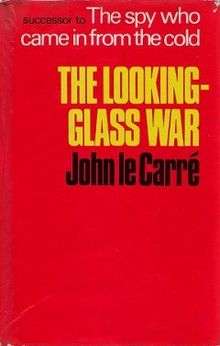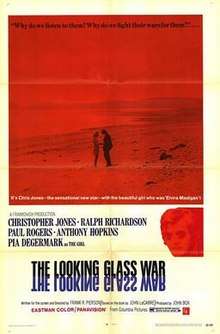The Looking Glass War
 First-edition cover | |
| Author | John le Carré |
|---|---|
| Country | United Kingdom |
| Series | George Smiley |
| Genre | Spy novel |
| Publisher | William Heinemann (UK) & Putnam (USA) |
Publication date | June 1965 |
| Media type | Print (hardcover) |
| Pages | 246 |
| ISBN | 0-434-41200-7 |
| Preceded by | The Spy Who Came in from the Cold |
| Followed by | A Small Town in Germany |
The Looking Glass War is a 1965 spy novel by John le Carré. Written in response to the positive public reaction to his previous novel, The Spy Who Came in From the Cold, Carre intended the book as a satire about the unglamorous nature of espionage and the danger of nostalgia. The book tells the story of an incompetent British intelligence agency known as The Department and its multiple botched attempts to verify a Communist defector's story of a Soviet missile buildup in East Germany.
Plot summary
During the early 1960s, a British military intelligence organisation referred to as "The Department" receives dubious information from a defector that Soviet missiles are being placed at Rostock, near the West German border. Although The Department ran successful aerial reconnaissance missions against the Nazis during the Second World War, it has since slipped into irrelevance and risks being assimilated by its rival, the more experienced and professional "Circus," led by chief "Control" and his second-in-command, George Smiley. Once a thriving division of British intelligence, The Department has been diminished to a skeleton crew of its own chief, Leclerc, a once-glorious air commander now reduced to a bureaucrat; his 32-year-old aide, Avery, who only took the job because he failed as a book publisher; Taylor, an elderly man who sees his job as his last chance at glory; and Haldane, a pompous but intellectually gifted researcher whose work on East Germany and the Soviet Union has single-handedly kept the organization funded by Whitehall.
Leclerc sees the missile intelligence as an opportunity to relive his glory days and regain ground in The Department's turf war with The Circus. To get aerial photographs, The Department pays a civilian pilot to "accidentally" divert his flight over the area. Taylor is dispatched to collect the film, where he's killed in a hit and run and the film is lost. Leclerc interprets the accident as a Stasi assassination and confirmation of the missile theory. Further blunders are made when Avery tries to retrieve Taylor's body in the hope that the film is still among his effects.
In spite of their setbacks, The Department persuades the responsible Minister to allow them to send an agent into East Germany. Leclerc avoids involving The Circus directly, representing the operation as a training exercise in order to obtain an obsolete crystal radio from Smiley. The Department reactivates one of its wartime agents, a middle-aged, naturalised Pole named Fred Leiser. During his preparation, Haldane and Avery have Leiser believe that The Department is still the large, vital and competent organisation he remembers from the war, instilling him with false confidence. Leiser and Avery strike up a deep friendship, with each seeing the other as his last chance at redemption: Avery feels like running a successful agent will mean he's finally done something meaningful with his life, while Leiser- in the throes of a midlife crisis- simply wants to feel useful again.
When crossing the border, Leiser kills a young East German guard, an outrage which is widely published in the East German media. The incident shakes Leiser. After stealing a motorcycle, he meets a young German girl who agrees to give him aid in exchange for him taking her back to the West. Leiser makes radio transmissions from her hotel room, forgetting to change frequencies as he continues to fixate on the border guard's death. The blunder − coupled with Leiser's outdated equipment − allows the Germans to quickly trace the source of his transmissions, and the hotel is raided by police.
Now made aware of the full extent of the Department's plan, Smiley is sent by the Circus to round up Leclerc, Haldane and Avery, and terminate the operation. After informing them about the debacle in East Germany, Smiley tactfully convinces Leclerc to abandon Leiser, explaining that his obsolete equipment and sloppy techniques will make denials of his role as a spy more plausible. Haldane and Leclerc are mollified by their new roles within an appended Research Section to the Circus; only Avery sobs inconsolably over the futility of the operation and the loss of Leiser. The missile site, meanwhile, almost certainly never existed. The defector has a history of trying to sell fabricated "information" to Western services, the photographs he provided as evidence are dubious, and Leiser was unable to corroborate any part of his story.
Characters
- Leclerc: Director of "The Department;" he can't let go of his glory days running successful aerial operations during WWII.
- Adrian Haldane: Veteran intelligence officer for The Department who has served since World War II. Assigned to run the operation and handle Leiser's training and infiltration into East Germany. Jaded and in ill health.
- John Avery: 32-year-old aide to Leclerc, personally assigned by Leclerc to assist Haldane in training Leiser.
- Fred Leiser: naturalised Pole who served as a recruited agent for The Department during World War II; has forgotten or is out of practice in nearly all his clandestine skills.
- Jack Johnson: Veteran wireless operator for the Department, assigned to refresh Leiser's wireless skills on an obsolete, World War II-vintage radio set.
- George Smiley: Intelligence officer and envoy from The Circus.
- Control: Director ("operational control") of The Circus.
Background and reception
According to le Carré in a foreword written for the 2013 Penguin Publishing reissue, the book was written as a direct response to the public reaction to his previous novel, The Spy Who Came In From the Cold. While le Carré had intended that novel as a deconstruction of the mythos that had sprung up around MI6 in the post-war era, he was disturbed that most readers in the United Kingdom regarded it as a romanticization of spy life and saw its protagonist, Alec Leamas, as a tragic hero. According to le Carré, it was largely American audiences who understood that the book was meant to convey the futility of spy work. Still wanting to convey the same message, le Carré wrote The Looking Glass War as an explicit satire, about a spy operation that was completely futile and pointless and the failure of which couldn't be considered a tragedy. He further sought to examine British nostalgia for the "glory days" of World War II, and how an ongoing fascination with England's victory in the conflict informed contemporary attitudes towards espionage. In doing so, he also culled details from his own time as an MI5 and MI6 agent, calling the book- along with The Secret Pilgrim- one of the most accurate reflections of his own experiences.[1]
The book received a mixed-to-negative critical response, which le Carré credits to readers being upset that the book presented blatantly incompetent and largely unsympathetic characters; although le Carré was upset with his fellow countrymen's response to the book, he was pleased that some American readers-- including members of the intelligence community-- appreciated the book as a satire.[2]
Adaptations

A film of the novel was released in 1969, starring Christopher Jones as Leiser, Ralph Richardson as LeClerc (sic), and Anthony Hopkins as Avery. It was directed by Frank Pierson.[3]
As part of a series of dramatisation of Le Carré's work, the "Complete Smiley" series, BBC Radio produced a radio play of The Looking Glass War in 2009. Broadcast on BBC Radio 4, it starred Ian McDiarmid as Leclerc, Piotr Baumann as Leiser, Patrick Kennedy as Avery, and Simon Russell Beale as George Smiley.[4] As with other plays in this series it is now available as a CD set as ISBN 978-1-4084-0086-9.
Release details
- 1965, UK, William Heinemann ISBN 0-434-41200-7, Pub date ? June 1965, Hardback
- 1965, USA, Putnam Pub. Group ISBN 0-698-10218-5, Pub date ? June 1965, Hardback
- 1965, USA, Coward-McCann, Inc., New York, Book Club Edition, Hardback
- 1966, UK, Pan, ISBN 0-330-20210-3, London, Paperwork
- 1985, UK, G. K. Hall & Co. ISBN 0-8161-4040-5, Pub date ? April 1986, Hardback (Large Print)
- 1991, UK, Hodder & Stoughton Ltd ISBN 0-340-55813-X, Pub date 21 November 1991, Hardback
- 1991, UK, Hodder & Stoughton (Coronet) ISBN 0-340-55446-0, Pub date 21 November 1991, Paperback
- 1992, USA, Ballantine Books ISBN 0-345-37736-2, Pub date ? March 1992, Paperback
- 1999, UK, Hodder & Stoughton ISBN 1-84032-108-3, Pub date 22 February 1999, Audio cassette (read by John le Carré)
References
- ↑ le Carré, John. Forward to The Looking Glass War. Penguin Publishing March 2013
- ↑ le Carré, John. Forward to The Looking Glass War. Penguin Publishing March 2013
- ↑ IMDb: The Looking Glass War (1969) Retrieved on 15 December 2009
- ↑ BBC: The Looking Glass War (2009) Retrieved on 15 December 2009